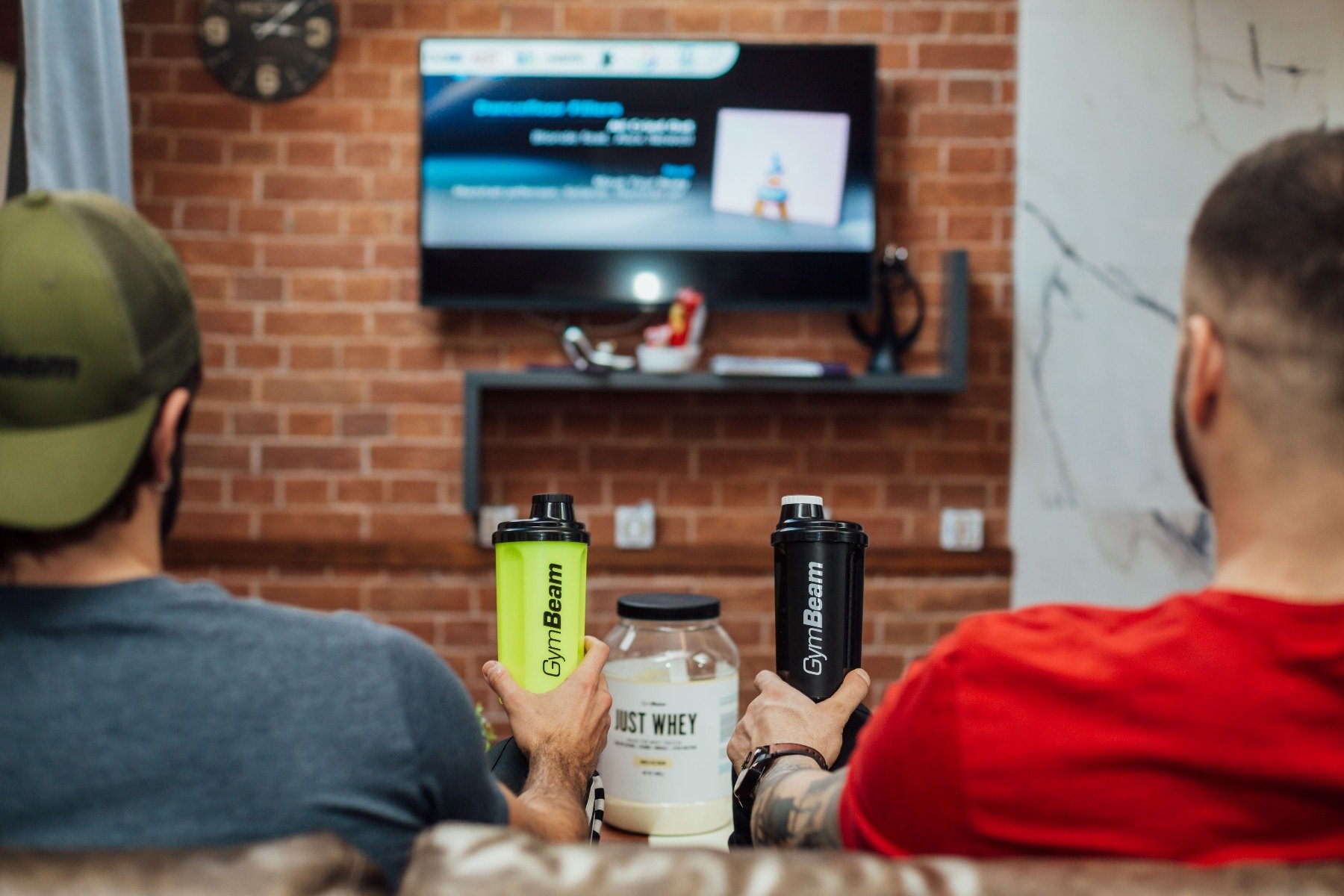Table of Contents
There are several formulas that you can use to calculate your basal metabolic rate and daily energy consumption. The value of energy consumption during the day can be a useful data element for assessing energy intake through food and lifestyle changes. Get to know prediction patterns that tell you how much energy your basic metabolism burns during the day.
What are energy income and expenditure?
The human body must receive energy in the form of food and beverages, which it converts and uses for various processes, such as [1]:
- Function of the organs in the body
- Muscle contraction
- Maintaining body temperature
- Growth
Each food or drink has its own energy value, which you will surely know from the nutrition tables on the food packaging. The value of this energy is given in calories, but also in joules, more precisely in kilojoules. What this number indicates is a mystery to many, so we’ll rather explain the difference between calories and joules. [1] [2]
Joules vs. Calories
Are you interested in why both units exist and their values are different while expressing the same data? In the past, energy from food was only given in calories, but is not a coherent unit of thermochemical energy. The unit Joule (j) belongs to the International System of Units (SI) and you can remember it from a physics course. The joule is the energy that is released when 1 kg is transferred at a distance of 1 meter with a force of 1 Newton. Do you remember that? The joule unit is used to calculate human energy, so joules should also be used to calculate the energy value of a meal. It has been recommended for more than 30 years to give energy in joules only, and it is difficult for consumers, scientists and “non-scientists” to leave the old unit after this time. You can find the value in calories, joules or kilojoules on the packaging of the products. It is possible that calories will no longer be consumed over time, but until then it is not a bad idea to know the difference between them. [3]
Foods and meals have different energy values, which depend on the macronutrient content. Food is different, but energy intake is also different for humans, because each of us has different energy needs, which can be caused by different factors:
- Genetics
- Gender
- Body weight
- Height
- Physical activity
- Climate conditions in which we live..
To better understand the energy content of foods, it is best to start with the joule / calorie ratio. [1]
1 kcal (kilocalories) = 1,000 cal (calories)
1 kJ (kilojoules) = 1,000 joules
1 MJ (megajoule) = 1,000 kJ or 1,000,000 joules
1 Kilocalorie (kcal) = 4,184 kilojoules (kJ)
This is the basic starting point. Let us now turn to food and its energy value. Nutrients are classified from the highest energy to the lowest energy content: [1] [4]
- Fats – 9 kcal (37 kJ)/g
- Alcohol* – 7 kcal (29 kJ)/g
- Protein – 4 kcal (17 kJ)/g
- Carbohydrates – 3,75 kcal (16 kJ)/g
* Alcohol has been added to the list because its consumption increases energy intake. However, it is not a nutrient as it has a negative effect on physical growth, development and regeneration. [4]

Food intake should be balanced to prevent weight gain and obesity. You are probably familiar with the frequently used statement that energy supply and consumption should be the same. When converted into a meal, the energy value should be 1 to 1.4 kcal / g, i.e. 4.2 to 6.3 kJ / g. The risk of weight gain and obesity arises when the food has an energy content of more than 2.5 kcal / g. Not easy to imagine? Your lunch consists of several foods with different nutrients and therefore different energy values. For example, lunch may consist of meat, side dishes and salad weighing 500 g. The difference, however, is that these represent 500 g of 200 g of meat, 150 g of French fries and 150 g of salad or 200 g of meat, 50 g of French fries and 250 g of salad. The resulting gears have a different energy value. The body uses energy from food for the processes already mentioned. For a better idea, we can say that 1 kcal is the amount of heat needed to raise the temperature of 1 liter of water by 1 ° C. [2] [4]
You might be interested in these products:
Daily energy consumption and its parts
Do you want to reduce or at least maintain your weight and not gain weight? Regardless of your goals, you want to achieve the desired ratio between energy income and expenditure. More specifically, you need to know the daily energy consumption, on the basis of which you can adjust the energy supply from food or the consumption itself.

Total energy consumption (TDEE) is known as TDEE (Total Daily Energy Expenditure). It represents the total number of calories you burn during the day and is determined by 4 components [5]:
- Basal Metabolic Rate
- Thermic Effect of Food
- Non-Exercise Activity Thermogenesis
- Thermic Effect of Activity
Mathematically, the total daily energy consumption corresponds to the sum of these 4 components. [5]
TDEE = BMR + TEF + NEAT + TEA
The basal metabolism produces energy for the functioning of basic vital functions such as breathing and blood transport in the human body. It also works when you’re not doing anything and resting in front of the TV in the evening. However, the basic metabolism does not include any physical activity we do during the day or the digestion of food. The rate of basic metabolism is the calories that the body burns for these needs. [5] [6]

The thermal effects of food are the calories that the body burns during food processing. The human body also needs energy to break down and process food. Macronutrients have a different thermal effect – proteins (20-35%), carbohydrates (5-15%) and fats (0-5%). What do these percentages mean? For example, try imagining 100 calories of the listed nutrients. During the digestion of 100 calories of protein, 20-35 calories are burned during digestion, and of course it is less with fats and carbohydrates. Adding high-protein ingredients to your diet increases the thermal effects of foods and the number of calories the body takes care of during digestion. [7]
The thermogenesis of non-exercise activities is part of the calories you burn during the day through various activities other than exercise, sleep, and food. This category includes normal walking during the day, walking the dog, or even shopping. This component can be vastly different for people because workers have a much higher value than people with sedentary jobs. Non-physical thermogenesis can play an important role in weight control. However, the mechanism that regulates this type of thermogenesis is not yet known to scientists. Remember that ironing, climbing stairs, or normal daily activities also affect your metabolism. [5] [8]

The thermal effect of the activity is the exact opposite of thermogenesis without training. It is part of the calories the body burns during exercise. This includes all types of training, such as weight training, cardio training, or CrossFit. [5]
Methods for calculating energy consumption
There are various formulas that can be used to calculate energy consumption. These include Harris Benedict or Mifflin-St Jeor formulas for calculating the basal metabolic rate, the results of which you can use with the Katch-McArdle multiplier.
Harris-Benedict Formula
The Harris Benedict formula is one of the best known methods for calculating basal energy consumption. Harris Benedict formulas were created in 1919 based on a study by James Arthur Harris and Francis Gano Benedict. They were created to establish standards for basal energy consumption and to compare them with the energy consumption of people suffering from various diseases such as diabetes. Formulas are one of the most common methods and were used until 1990 when a new Mifflin St Jeor formula was released. Harris Benedict formulas are more than 100 years old and their dates were changed in 1984 to improve accuracy. However, it is great to see that the rate of basic metabolism was studied at the beginning of the last century. [9] [10]
Harris Benedict formulas include body weight, height, age, and gender. Thanks to them, you can easily calculate the rate of your basic metabolism per day and find out how many calories you need per day to maintain weight. You can then use the BMR values to calculate your total daily energy consumption. [10] [11]
BMR (for men) = 66.47 + (13.75 x weight in kg) + (5.003 x size in cm) – (6.755 x age in years)
BMR (for women) = 655.1 + (9.563 x weight in kg) + (1.85 x size in cm) – (4,676 x age in years)
So, if you’re a 30-year-old woman, 165 cm tall and 55 kg in weight, the formula looks something like this:
BMR = 655,1 + (9,563 x 55) + (1,85 x 165) – (4,676 x 30)
655,1 + 525,954 + 305,25 – 140,28 = 1346,024 kcal
So, BMR is 1346.024 calories per day. Your body burns so many calories a day due to the basic metabolism. The minimum number of calories you need per day for a healthy functioning of the body is 1346 calories. Try to calculate your basal metabolic rate. [5]
The result of the Harris Benedict formulas gives you the BMR value, which you can multiply by the Katch-McArdle multiplier to calculate the total daily energy consumption. For the recalculation of our daily energy consumption, we present standard Katch-McArdle multipliers and a modified version by Michael Matthews. [5] [12]
1.2 = lack of exercise (minimal or no exercise)
1.375 = slightly active ((light exercise / sport 1-3 days / week)
1,55 = moderate activity ((moderate exercise / sport, 3-5 days / week)
1.725 = high activity (6-7 days a week hard exercise or sport)
Some sources also define a multiplier with a value of 1.9 but a different definition of activity.
1,9 = extremely high activity (difficult training, difficult manual work, training twice a day) [5]
1,9 = extra activity (6-7 days a week heavy exercise or sports and physical work). [12]

Calculate your all-day energy consumption by multiplying the multiplier by the basal metabolic rate.
TDEE = BMR x Katch-McArdle multiplier
TDEE = 1346,024 x 1,375 (for example, if you are a woman who trains twice a week)
TDEE = 1850,783 Calories
However, Michael Matthews also mentions modified multipliers. The author does not build on research, but on practice with thousands of people. According to him, the amount of energy burned can be overestimated. If standard multipliers are used, the calorie deficit may be too small and there may be a large excess in the intake. The result is less fat loss during body shaping and excessive fat growth in the volume phase. Modified Matthews multipliers provide a better starting point. Their use is the same as for standard multipliers. [12]
1,15 = sedentary type (minimal or no exercise)
1,2 to 1,35 = light activity (1-3 hours of exercise or sport per week)
1,4 to 1,55 = moderate activity (4-6 hours of exercise or sport per week)
1,6 to 1,75 = high activity (7-9 hours of exercise or sport per week)
1,8 to 1,95 = extra high activity (10 or more hours of exercise or sport per week)
The use of standard or modified multipliers to calculate energy consumption is up to you and your decision.
Mifflin-St Jeor Formula
The formula known as Mifflin-St Jeor, like the Harris Benedict formula, is used to calculate energy consumption. It was first published in a study by these men in 1990. At that time it was considered the more current version of the Harris Benedict formula and was also better suited to the modern lifestyle. The difference in value between the new and older models is about 5%, with the Mifflin-St Jeor formula being more accurate. For comparison, we present a formula for men and women, but also an example: [10]:
BMR (for men) = (10 x weight in kg) + (6.25 x height in cm) – (5 x age in years) + 5
BMR (for women) = (10 x weight in kg) + (6.25 x size in cm) – (5 x age in years) – 161
As with the Harris Benedict formula, you can then use the Mifflin-St Jeor formula to recalculate TDEE using Katch-McArdle multipliers.

Would you like to calculate your daily energy consumption according to the Mifflin-St Jeor formula, but not laboriously calculate it on a calculator? Use our Online-BMR-Calculator.
A 2005 study examined the literature to verify the accuracy of prediction patterns. It was concluded that the following formulas are most commonly used in clinical practice [13]:
- Harris-Benedict
- Mifflin-St Jeor
- Owen
- World Health Organization/Food and Agriculture Organization/United Nations University [WHO/FAO/UNU]
Of the formulas mentioned, Mifflin-St Jeor was the most accurate and had the narrowest range of error. Mifflin-St Jeor predicted a resting metabolic rate in the range of 10% of the measured value in more non-obese and obese people than in other formulas. [13]
As you may have noticed, besides Harris-Benedict and Mifflin-St Jeor there are other formulas for calculating energy consumption. These include, for example, Katch-McArdle, Katch-McArdle (Hybrid), Cunningham or a revised version of Harris-Benedict from 1984. On the Internet you can find calculators that do this for you and you just have to enter your personal parameters. However, the results of the aforementioned study from 2005 indicate that these are only predictive patterns. As a result, some of them may differ from the fair value. [14]

The resulting values may be indicative, but it is difficult to say whether they are 100% suitable for you. We believe that you will try out some of the formulas and help you achieve your fitness goals while achieving the physique of your dreams. Would you like your friends to learn more about these basic metabolic formulas? Then feel free to share the article.
[1] Energy intake and expenditure – https://www.nutrition.org.uk/nutritionscience/obesityandweightmanagement/energy-intake-and-expenditure.html?start=1
[2] Jennifer R. Scott - How to Boost Your Energy Expenditure – https://www.verywellfit.com/what-is-energy-expenditure-3496103
[3] CHAPTER 3: CALCULATION OF THE ENERGY CONTENT OF FOODS - ENERGY CONVERSION FACTORS – http://www.fao.org/3/Y5022E/y5022e04.htm
[4] Macronutrients – http://opkp.si/en_GB/cms/help/assistance-in-working-with-open/macronutrients
[5] Robert Schinetsky - What is My TDEE (Total Daily Energy Expenditure)? – https://steelfitusa.com/2018/10/calculate-tdee/
[6] Calculate Your Basal Metabolic Rate (BMR) – https://www.bodybuilding.com/fun/bmr_calculator.htm
[7] Mike Roussell - Ask The Macro Manager: What Is The Thermic Effect Of Food – https://www.bodybuilding.com/fun/ask-the-macro-manager-what-is-thermic-effect.html
[8] Levine JA - Non-exercise activity thermogenesis (NEAT). – https://www.ncbi.nlm.nih.gov/pubmed/12468415
[9] Frankenfield DC, Muth ER, Rowe WA - The Harris-Benedict studies of human basal metabolism: history and limitations. – https://www.ncbi.nlm.nih.gov/pubmed/9550168
[10] Alastair Hazell - BMR Formula (Basal Metabolic Rate) – https://www.thecalculatorsite.com/articles/health/bmr-formula.php
[11] Physical Activity and Controlling Weight – https://www.k-state.edu/paccats/Contents/PA/PDF/Physical%20Activity%20and%20Controlling%20Weight.pdf
[12] Michael Matthews - This Is the Best TDEE Calculator on the Web (2020) – https://legionathletics.com/tdee-calculator/
[13] Frankenfield D, Roth-Yousey L, Compher C - Comparison of predictive equations for resting metabolic rate in healthy nonobese and obese adults: a systematic review. – https://www.ncbi.nlm.nih.gov/pubmed/15883556
[14] SCIENTIFIC MACRO CALCULATOR – https://bodyofscience.co.uk/pages/macro-calculator

